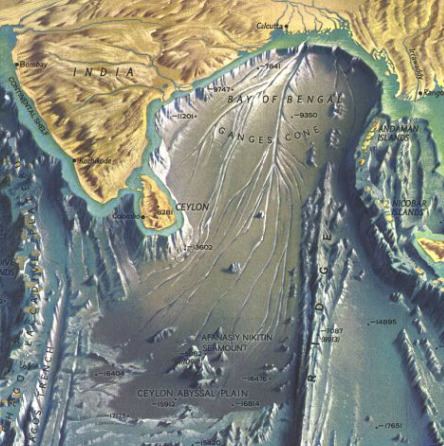SOURCE: AFI


The Bay of Bengal, a vast expanse of water nestled between India, Bangladesh, Myanmar, and Sri Lanka, has long been recognized as a strategic asset for India’s maritime security. Its unique geographical features, coupled with its depth profile, make it an ideal sanctuary for India’s submarine fleet, especially its ballistic missile submarines (SSBNs) and attack submarines (SSNs).
One of the most significant advantages of the Bay of Bengal is its depth. Unlike other regions where the continental shelf extends far out into the ocean, the Bay of Bengal features a steep drop-off, allowing submarines to operate in deep waters without fear of detection. This depth profile provides a natural barrier against enemy surveillance and detection systems.
The depth of the Bay of Bengal, particularly in its central and southern parts, reaches more than 3,000 meters, making it one of the deepest maritime zones in India’s vicinity. This depth provides several key advantages for SSBNs.
The deeper the water, the harder it is to detect submarines. SSBNs, which are responsible for carrying India’s second-strike nuclear capability, benefit from this natural cloak, staying hidden from enemy anti-submarine warfare (ASW) systems. The dramatic continental drop-off allows Indian SSBNs to quickly descend into deep water and evade detection.
The Indian Navy’s bases along the eastern coast, such as those in Vishakhapatnam, are perfectly positioned for quick access to the Bay of Bengal’s deep waters. SSBNs can deploy rapidly and remain concealed within the safety of these deep waters while being close enough to Indian shores for logistical support.
1. Underwater Listening Posts (ULPs)
Chains of ULPs can serve as the first line of defense. These sonar systems can detect and track enemy submarine movements, providing early warning of hostile activity. By strategically positioning ULPs along the continental shelf, India can monitor any submarine incursion into the Bay of Bengal from the Andaman Sea, the Strait of Malacca, or the eastern reaches of the Indian Ocean.
2. Maritime Patrol Aircraft (MPA)
MPA, such as the Boeing P-8I Poseidon, play a crucial role in ASW and surveillance. These aircraft, equipped with advanced sensors and sonar buoys, can patrol vast areas and relay real-time data to surface ships and submarines. MPAs can identify, track, and neutralize enemy submarines before they can enter the deeper regions where India’s SSBNs operate.
3. Diesel-Electric Submarines (SSKs)
SSKs, though smaller than SSNs, can play a significant role in denying enemy submarines access to critical areas in the Bay of Bengal. With their ability to operate silently and engage in close-quarter submarine warfare, SSKs form an essential part of the defensive network. By patrolling chokepoints and shallow waters near the Andaman and Nicobar Islands, they can deter or neutralize enemy submarines.
4. Extra-Large Unmanned Underwater Vehicles (XLUUVs)
The future of underwater warfare will increasingly rely on unmanned platforms. XLUUVs, which are capable of long-range, autonomous operations, can be deployed to monitor and track enemy submarines or surface vessels in contested waters. These unmanned systems can conduct surveillance in the deeper sections of the Bay of Bengal, allowing SSBNs to operate with minimal exposure.
5. Surface Assets
Surface ships, especially frigates and destroyers equipped with advanced ASW capabilities, will form the outermost layer of defense. These ships, stationed along the Bay of Bengal’s periphery, can coordinate with MPAs, submarines, and ULPs to create a comprehensive defense network. Additionally, surface ships will serve as a deterrent to enemy surface fleets or aircraft attempting to breach India’s maritime borders.
The Bay of Bengal and southern Indian Ocean are not only strategic playpens for India’s SSBN and SSN fleets but also crucial to the country’s goal of securing strategic autonomy in the Indo-Pacific. With mounting geopolitical tensions, especially in the South China Sea and the Indian Ocean Region (IOR), it is imperative for India to establish a credible and secure second-strike capability.